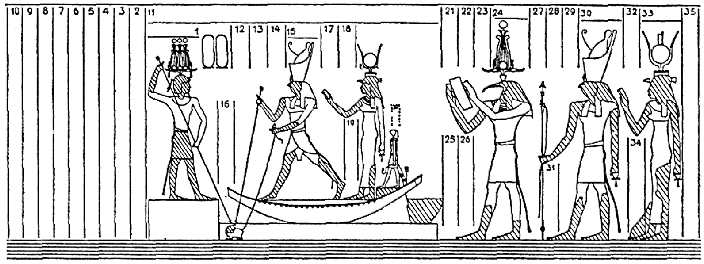
| king in atef-crown| | Thoth in hemhem-crown| | Isis in horned sun-disk|
N.B., column numbers in the drawing reflect verse numbers in Fairman's transcription of the text.
Point and click certain details in this drawing to see enlargements of them.

This particular production of the sacred drama, as recorded on the walls of Edfu Temple, was probably first performed sometime around 110 B.C., early in the reign of King Ptolemy IX (r. 116-81 BC)--before he was first deposed by his mother, Queen Cleopatra III. Still, there is no doubt that the drama is based on earlier archetypes that extend far back into Egyptian history.Description: The lector priest (not depicted) introduces the principal characters: the two falcon-headed deities, Horus Lord of Behdet, and Horus Lord of Mesen (not depicted); Isis, their mother; the ibis-headed god, Thoth; the King of Upper and Lower Egypt, Ptolemy IX ; and his mother, Queen Cleopatra III (not depicted).
- The king wears an Atef-crown over a short wig tied with medjeh-headband. He is bare-chested and wears a kilt and lion's tail.
- Horus of Behdet wears the red and white Double Crown, a shendyt-kilt, lion's tail, and white T-shirt-like blouse.
- Isis wears her typical crown of sun disk and cow's horns (the horned disk) over a cap in the form of a vulture's body set on a wig-cover with long vertical lappets.
- Thoth wears a Hemhem-crown, a plain kilt, lion's tail, and is bare-chested. He holds a roll of papyrus fom which he reads his invocation.
- Horus of Mesen wears a red and white Double Crown, a plain kilt, lion's tail, and is bare-chested. He carries a large rope-strung harpoon.
- Horus and Isis also carry ankhs.
After the introductions, Horus the Behdetite and Isis board a boat on the Sacred Lake of Edfu Temple, and the king ascends a podium on the left (stage right). The evil god Seth has assumed the form of a hippopotamus and stands in the water. Horus has caught the hippo by the hind legs with a chain, and he and the king procede to mime the harpooning of it. All the while, the gods and chorus chant laudatory invocations.
Note: Since the Egyptians generally believed that religious depictions and hieroglyphs on the walls of temples were actually alive in spirit, the hippopotamus is always shown very small, so that the relief of the evil deity might not do spiritual harm to the temple or anyone associated with the drama.
In the actual production, the Egyptians might well have employed an actual hippopotamus, so that the actors and priests might have been in some real danger, and would have actually killed the creature as part of the production. It is not unreasonable to think of the production as a combination of modern drama, religious liturgy, and bull-fight (of sorts!).
| Return to Scenes and Details-page |